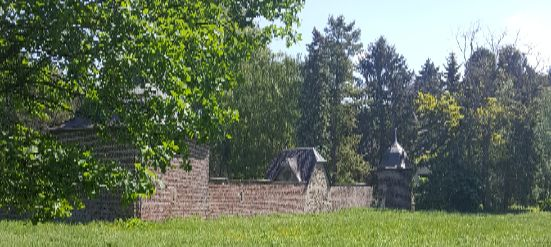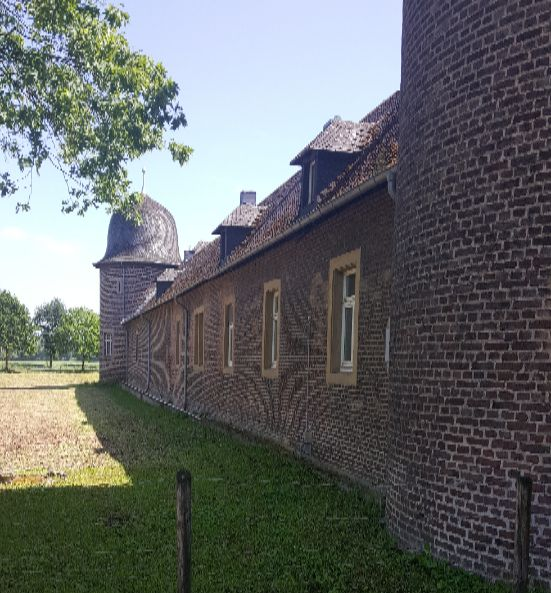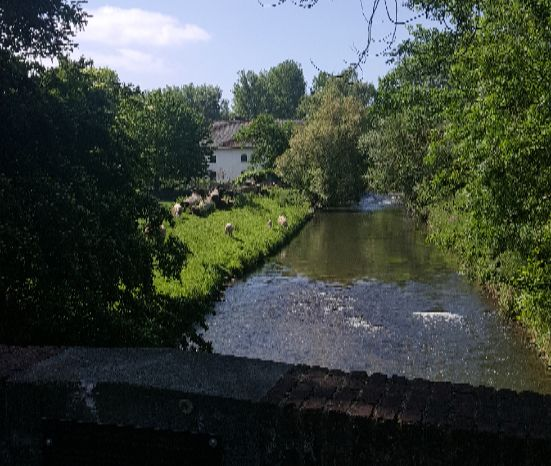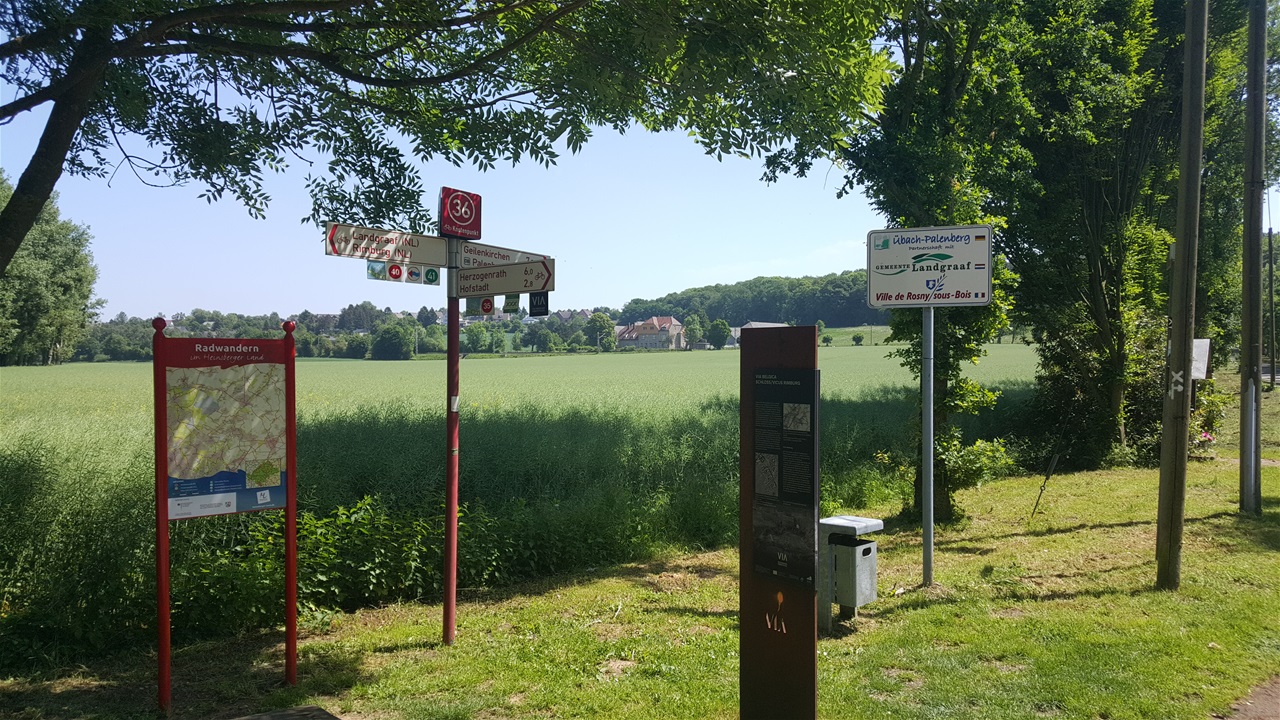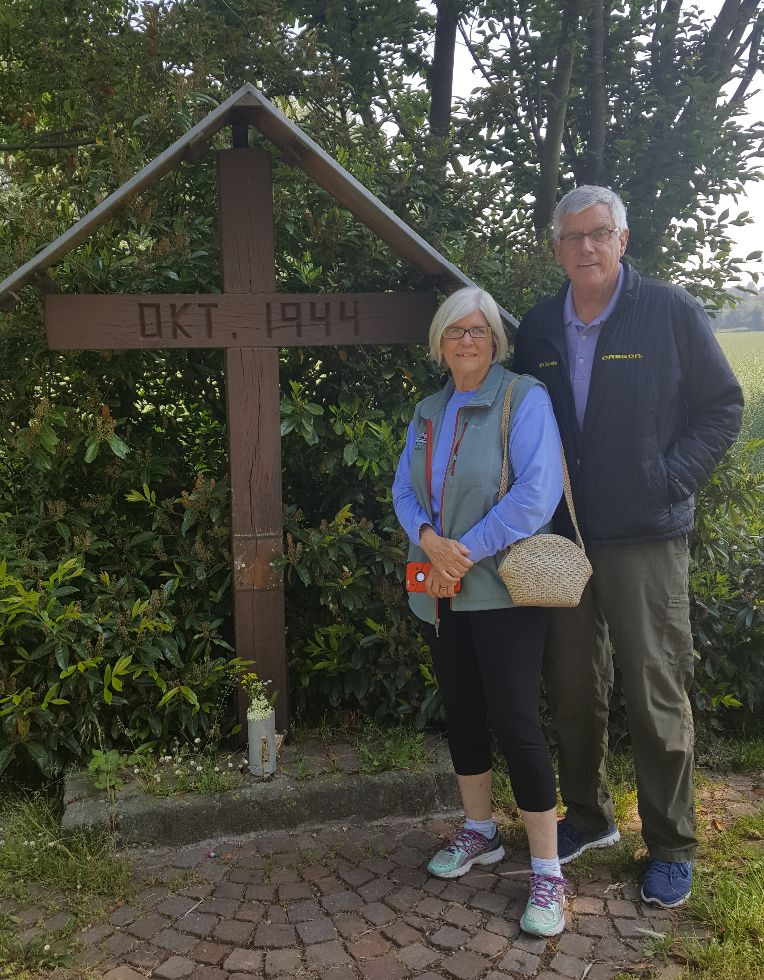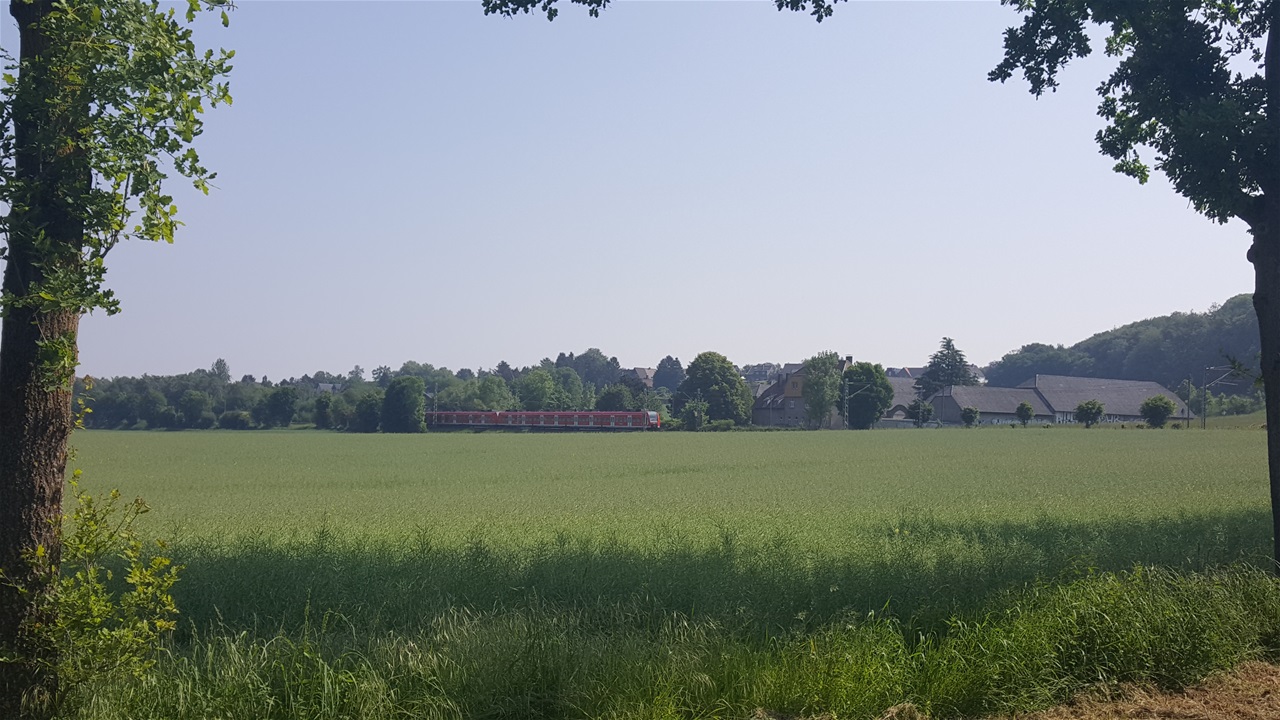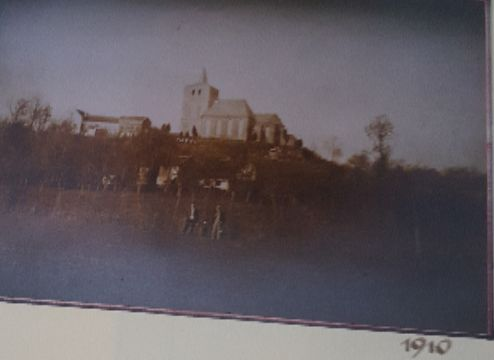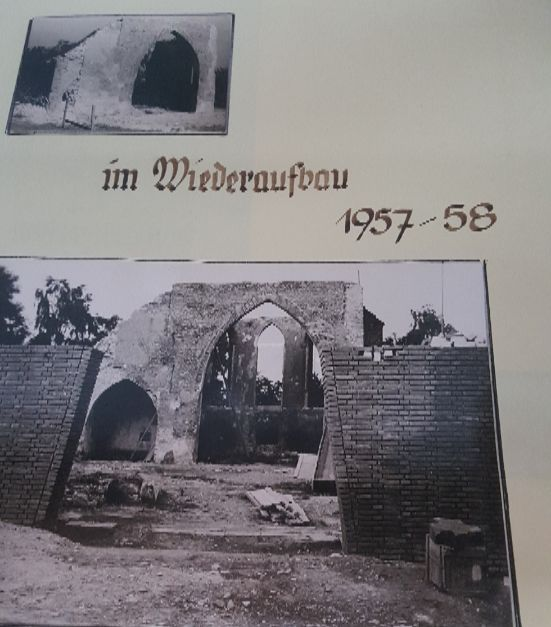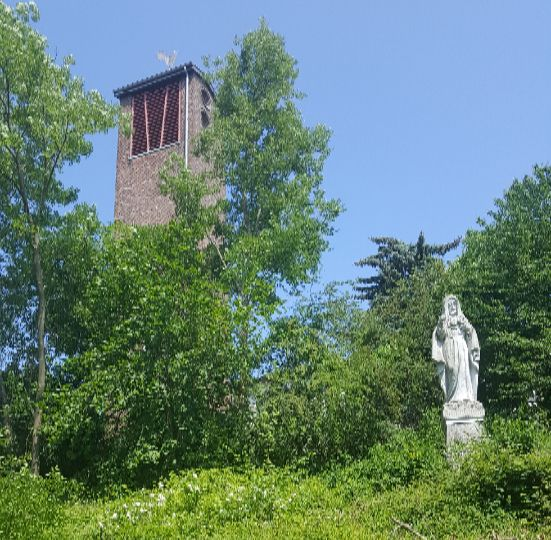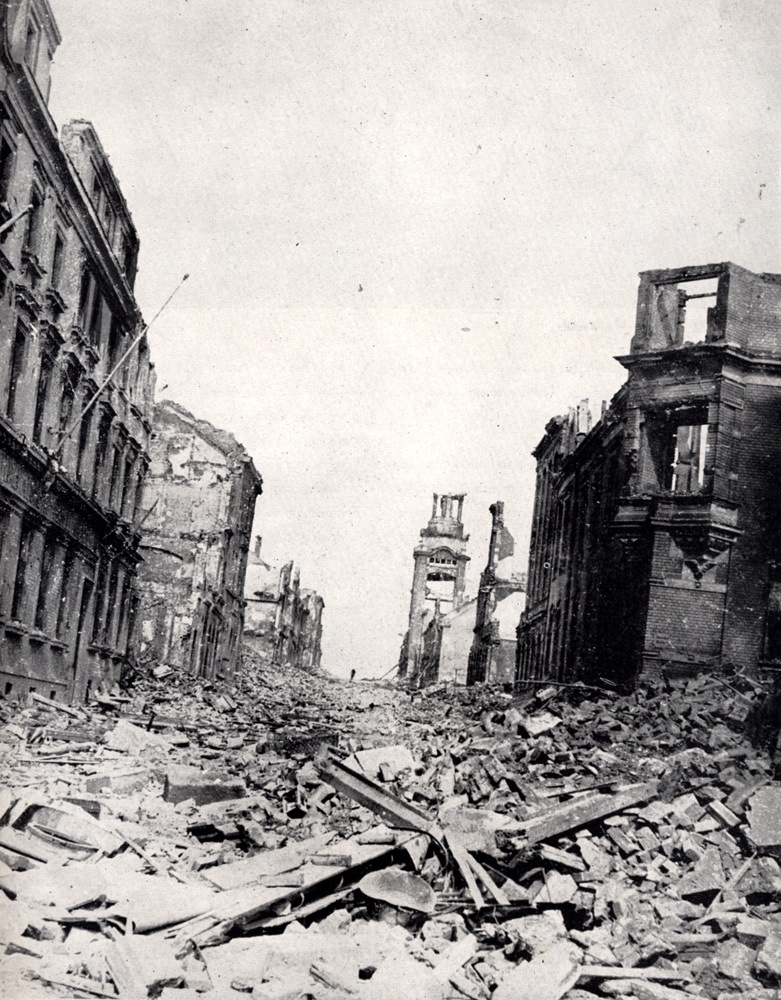Lieutenant Harold Huston was likely one of the first Americans to step foot in Germany.
This is a close up view of the Rimburg Castle, which was defended for the first two days by Germans entrenched in the fortification. The Americans had a difficult time getting tanks across the Wurm River, so the infantry had to attack the fortification without heavy armor. The battle ended up with room to room fighting.
The Aachen battle was the first major battle on German soil. The Americans had been pushing through France and The Netherlands for the summer months, and now they stood at the doorstep of Germany. The Germans had built a series of fortifications called the "West Wall" or the Siegfried Line, which stretched for miles along the border of Germany, The Netherlands, Belgium and France. These fortifications were designed to be a significant obstacle for the infantry with pillboxes all along it, and with "dragons teeth" to stop tanks.
Both the US First Army (the "Big Red One") and the 30th Division were focused on a strategy to encircle the city and then take care of the city itself as they could. The objective was to move quickly and move on to the rich Ruhr industrial land to the east before the final attack on Berlin.
The Germans had built up a strong defense behind the West Wall and were now determined to defend Germany. The war changed from liberating French and Netherlands cities to moving into the enemy territory.
Intially, the German commanders had considered giving up Aachen, as it was difficult to defend, but Hitler ordered its defense to the last man.
For two weeks before the upcoming battle, the 30th Division did field exercisies to learn strategies and tactics to overcome the West Wall. Sand tables were built and individual units were given specific assignments for the upcoming battle.
Dad's unit, the 119th was assigned, along with the 117th, were chosen to lead the battle, beginning at 1055 hours on the morning of October 2. They were the "tip of the spear" in military parlance. They had an entire army and country backing them with supplies and equipment.
The 119th initial assignment was to take fortified Rimburg Castle, which ultimately took two days of hard fighting. Tanks were eventually brought in across the Wurm River on a bridge the historians of the 119th called the "smallest and most important bridge in our history." The Germans made the bridge building very difficult as they knew it would allow the Americans to bring their armor to the battle.
Lieutenant Harold Huston was likely one of the first Americans to step foot in Germany.
On that morning, after weeks of preparation, they knew the German's were in highly defended positions and they were ready to fight. Dad's unit was figuratively and literally going into the teeth of the enemy. The situation was not unlike the Normandy beaches. The German's knew the Americans were coming and they had the high ground.
Going across that small river into Germany had to be one of the most daunting tasks. It was the definition of putting your life on the line for your country. I believe most of those guys did it, even though they were afraid, to support their fellow soldiers.
After the Rimburg Castle was taken, the 119th had an expanse of open country to a railroad that was backed by hills. The Germans had fortified these hills with pillboxes and hardened defensive positions to overcome. Ultimately, they achieved their objectives, with the assistance of the 117th Regiment (a brother regiment of the 119th) and a Task Force.
Below is a quote from Captain Marvin M. Smith, from the 120th Regiment, a brother unit of Dad's 119th, describing the scene prior to jump off on October 2, in front of the Wurm River and the West Wall. It shows the seriousness of the situation and what some soldiers did:
I slept a only few short hours and then was awakened to hear orders from Battalion Headquarters that K Company would again be called upon to clear out any enemy to our front down to the canal. We were to “jump-off” within the hour. One of my Sergeants came up and informed that one of the men had shot himself in the foot and was recommending an investigation into the incident. There was little time for investigations. The motive for a self-inflicted wound was clear: fear of death in combat could drive a man to the brink of insanity.
Here is another quote from Captain Marvin M. Smith of the 120th Regiment. This was on the day of the attack on Rimburg Castle. The river they are describing is the Wurm River:
I set up my command post, radios, telephone and runners about 100 feet behind the canal. At 1300, the commence attack signal was given. I heard several loud explosions and soon received word from a platoon leader that the engineers had dynamited part of the hedgerow to make a place for the ladders and that this blasting had stunned many of our men, and they were unable to proceed. Furthermore, the ladders, intended for use as foot-bridges across, were to short to complete the span. I told them we must cross anyway, an I turned to Lt. Hulbert, my executive officer, and told him “Lets go. We must lead them across.”
As Dad was a Lieutenant in Intelligence, I am not sure as to how much forward combat he experienced. I think that much of his daily assignment was to find out what was going on in the front or be on patrol to reconnoiter enemy positions. The quote above leads me to believe that when major activities occurred or when an attack commenced, he was right in the middle of it. He said to me once, tongue-in-cheek, that I should never become a second lieutenant "because they shoot at you from in front and from behind." As I have reflected on that comment, I think there is likely more truth to the comment than just humor. Leaders like him were required to stand up and move forward or hold a position, when the rest of the troops might prefer not to.
When visiting the Rimburg Castle and the jump off point for the 119th, we went about 1 mile to the left of the Rimburg Castle crossing to Mariaberg, the site of the 117th Regiment's jump-off on October 2 into Germany. The 117th had a better time off it on the 2nd, and made good progress. As a lead group approached the Catholic Church situated on a large hill overlooking Mariaberg, the Church exploded, with the entire chuch demolished with the steeple going high into the air. The Germans had set explosives in the Church and decimated it as it could be used as a lookout. Below are some photos of the church, before and after. We met the parish priest, who didn't speak English, but we were able to communicate enough with him, and he showed us the photos.
Hard fighting ensued over the next days and weeks around Aachen. Dozens of towns were taken by the 119th and other units of the 30th. The West Wall (the "Seigfried Line") was breached and the German counterattacks were repelled, with many casualties on both sides. Books have been written on this battle. The 30th pushed to encircle the city and meet up with the 1st Division. Headquarters pushed the units hard to make that happen. German resistance was fierce. On October 15, two weeks after the initial push and of daily battles, soldiers from the 119th Regiment of the 30th met up with the vanguard units of the 1st.
Here is a quote from the 119th history: The breaching of the Siegfried Line and the encirclement of Aachen had taken 16 days of continuous fighting, during which the 119th Regiment suffered 661 casualties. Of these, 45 were killed, 482 were wounded, and 134 were missing in action. We had reduced 131 pillboxes, 73 fortified positions,and had taken 1243 enlisted prisoners and 26 officers. The 119th saw the heaviest fighting of the 30th Division in the fighting for Aachen.
The 119th fought and took several cities that are suburbs of Aachen, including Ubach, Herzogrenrath, Bardenburg, Wurselen and Crucifix Hill. Below is a photo of the damage inflicted on Wurselen.
